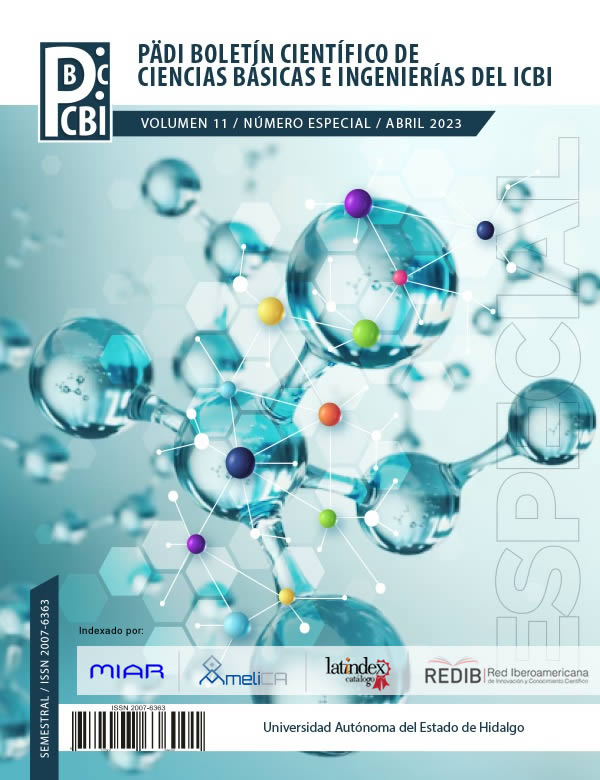Recuperación de Au(III) con líquidos iónicos encapsulados. Efecto del emulsificante
DOI:
https://doi.org/10.29057/icbi.v11iEspecial.10363Palabras clave:
microcápsulas, Cyphos IL 101, emulsiones, goma arábiga, Au(III), cyphos, goma, arábicaResumen
La producción mundial de chatarra electrónica es un problema ambiental. Parte importante de estos residuos son metales preciosos. Para recuperarlos, se utilizan diversos métodos de separación, como la extracción con extractantes encapsulados, para lo cual, es necesario fabricar emulsiones estables. En este trabajo se presentan resultados de la fabricación de materiales a base del líquido iónico (LI) Cyphos IL 101 (cloruro de trihexil(tetradecil)fosfonio) encapsulado con alginato de calcio, por gelificación inversa, utilizando emulsiones del LI con carboximetilcelulosa (CMC) y goma arábiga (GA) como emulsificante. Se estudió la estabilidad de los materiales, así como su desempeño en la extracción de Au(III), en función del tiempo de fabricación. Los resultados obtenidos son comparados con los obtenidos previamente con materiales similares sin GA. Las emulsiones y las microcápsulas con GA muestran una mayor estabilidad. Al incrementarse el tiempo de fabricación, ambos materiales muestran una disminución de la capacidad y la velocidad de extracción de Au(III), pero estas variaciones son menores para las microcápsulas con GA.
Descargas
Información de Publicación
Perfiles de revisores N/D
Declaraciones del autor
Indexado en
- Sociedad académica
- N/D
Citas
Abdelbasir, S.M., Hassan, S.S.M., Kamel, A.H., El–Nasr, R.S. (2018). Status of electronic waste recycling techniques: a review. Environmental Science and Pollution Research, 11(8), 15–30. DOI: 10.1007/s11356-018-2136-6
Ahirwar, R., Tripathi, A. K. (2021). E–waste management: A review of recycling process, environmental and occupational health hazards, and potential solutions. Environmental Nanotechnology, Monitoring & Management, 15(10), 30–45. DOI:10.1016/j.enmm.2020.100409
Appelqvist, I.A.M., Golding, M., Veeker, R., Zuidam, N.J. (2016). Emulsions as delivery systems in foods. Cap. 6. págs. 129–172. En: Jamileh M. Lakkis (Ed.), Encapsulation and controlled release technologies in food systems. DOI:10.1002/9781118946893.ch6
Bai, L., Huan, S., Li, Z., McClements, D. J. (2017). Comparison of emulsifying properties of food–grade polysaccharides in oil–in–water emulsions: Gum arabic, beet pectin, and corn fiber gum. Food Hydrocolloids, 66, 144–153. DOI:10.1016/j.foodhyd.2016.12.019
Campelo, P. H., Affonso Junqueira, L., Vilela de Resende, J., Domingues Zacarias, R., Barros Fernandes, R. V., Alvarenga Botrel, D., Vilela Borges, S. (2017). Stability of Lime Essential Oil Emulsion Prepared Using Biopolymers and Ultrasound Treatment. International Journal of Food Properties, 20(S1), S564–S579. DOI:10.1080/10942912.2017.1303707
Cyganowski, P., Garbera, K., Les´niewicz, A., Wolska, J., Pohl, P. (2017). The recovery of gold from the aqua regia leachate of electronic parts using a core–shell type anion exchange resin. Journal of Saudi Chemical Society, 21(6), 741-750. DOI:10.1016/j.jscs.2017.03.007
Dickinson, E. (1994). Protein–stabilized emulsions. Journal of Food Engineering, 22(1–4), 59–74. DOI:10.1016/0260-8774(94)90025-6
Dickinson, E., Galazka, V. B. (1991). Emulsifying behaviour of gum arabic. Part 1: Effect of the nature of the oil phase on the emulsion droplet–size distribution. Carbohydrate Polymers, 14(4), 373–383. DOI: 10.1016/0144-8617(91)90003-U
Islam, A., Ahmed, T., Rahman, A., Hasan, M., Monir, M. U., Aziz, A. A. (2019). Advances in sustainable approaches to recover metals from e–waste–A review. Journal of Cleaner Production, 244(20), 1–59. DOI:10.1016/j.jclepro.2019.118815
Kaur, G., Kumar, H., Singla, M. (2022). Diverse applications of ionic liquids: A comprehensive review. Journal of Molecular Liquids, 351, 118556, 1–19. DOI:10.1016/j.molliq.2022.118556
Khaliq, A., Rhamdhani, M., Brooks, G., Masood, S. (2014). Metal extraction processes for electronic waste and existing industrial routes: A review and australian perspective. Resources, 3(1), 152–179. DOI:10.3390/resources3010152
Lupo Pasin, B., González Azón, C., Maestro Garriga, A. (2012). Microencapsulación con alginato en alimentos. Técnicas y aplicaciones. Revista Venezolana de Ciencia y Tecnología de Alimentos, 3(1), 131–151. https://sites.google.com/site/1rvcta/v3-n1-2012/r8
Fraser, K.J., MacFarlane, D.R. (2009). Phosphonium–based ionic iiquids: An overview. Australian Journal of Chemistry, 62(4), 309–321. DOI:10.1071/CH08558
Morales, J. (2020). Microencapsulación de líquidos iónicos con alginato de calcio mediante gelificación inversa para la recuperación de Au(III). Tesis de maestría, Universidad de Guanajuato. http://repositorio.ugto.mx/handle/20.500.12059/4502
Navarro, R., Saucedo , I., Lira, M. A., Alatorre , A. (2017). Amberlite XAD resins impregnated with ionic liquids from Au(III) recovery. Macromolecular Symposia, 374(1), 1–8. DOI:10.1002/masy.201600134
Navarro, R., Saucedo, I., Lira, M. A., Guibal, E. (2010). Gold (III) recovery from HCl solutions using Amberlite XAD–7 impregnated with an ionic liquid (Cyphos IL–101). Separation Science and Technology, 45(12,13), 1950–1962. DOI:10.1080/01496395.2010.493116
Pal, A., Mondal, M. H., Adhikari, A., Saha , B., Bhattarai, A. (2021). Scientific information about sugar–based emulsifiers: a comprehensive review. RSC Advances, 11(52), 33004–33016. DOI:10.1039/D1RA04968B.
Patel, S., Goyal, A. (2015). Applications of natural polymer gum arabic: A review. International Journal of Food Properties, 18(5), 986–998. DOI: 10.1080/10942912.2013.809541
Ritcey, G. M. (2006). Solvent extraction in hydrometallurgy: Present and future. Tsinghua Science and Technology, 11(2), 137–152. DOI:10.1016/S1007-0214(06)70168-7
Santagapita, P. R., Mazzobre, F. M., Buera, P. M. (2011). Formulation and drying of alginate beads for controlled release and stabilization of invertase. Biomacromolecules, 12(9), 3147–3155. DOI:10.1021/bm2009075
Vincent, T., Parodi , A., Guibal, E. (2008). Immobilization of Cyphos IL–101 in biopolymer capsules for the synthesis of Pd sorbents. Reactive & Functional Polymers, 68(7), 1159–1169. DOI:10.1016/j.reactfunctpolym.2008.04.001
Wei, W., Kumar, H., Bediako, J., Sang, Y. (2016). Aliquat–336–impregnated alginate capsule as a green sorbentfor selective recovery of gold from metal mixtures. Chemical Engineering Journal, 289(14), 413–422. DOI:10.1016/J.CEJ.2015.12.104
Zhu, Y., Sengupta, A. K. (1992). Sorption enhancement of some hydrophilic organic solutes though polymeric ligand exchange. Enviromental Science and Technology, 26(10), 1990–1998. DOI:10.1021/es00034a017
Zuidam, N.J., Shimoni, E. (2010). Overview of microencapsulates for use in food products or processes and methods to make them. En: Zuidam, N.J., Nedovic, V. (Eds.). Encapsulation technologies for active food ingredients and food processing. Springer, New York. N.Y. Pags.: 3-29. DOI:10.1007/978-1-4419-1008-0_2




















